INSTITUT SUPERIEUR D'ANTHROPOLOGIE
INSTITUTE OF ANTHROPOLOGY
ONLINE COURSES / COURS A DISTANCE
INSCRIPTION : Année Universitaire 2012/2013
REGISTRATION : Academic Year 2012 / 2013
ITALIE – 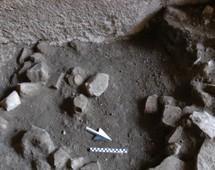 Isonzo river - The remnants of what is likely to be a 200-meter Roman bridge that crossed the River Isonzo in Northern Italy have been unearthed by a specialized architectural team. The archaeologists were able to carry out the works when the summer heat dried up the river, permitting excavation works to be carried out on the Savogna bank of the river towards Udine. In the past few days they discovered the rectangular bases of large pillars that used to uphold a Roman bridge that spanned the Isonzo river where the Mainizza church now is. Their large size, 9 meters by 4.5 meters, are a testament to the width of the bridge. Groups of digging teams belonging to specialized archaeological research companies ArcheoTest and Petra carried out the excavations under the scientific supervision of expert Angelina De Laurenzi of the Italian Culture Ministry. The archaeological works were partially sponsored by roads company Autovie venete. Based on discoveries in the area dating from 1963 to 2003, the bridge, along which the via Aquileia-Emona crossed, was probably about 200 meters wide and was borne by some 11 pillars. Further archeological research is being carried out to discover if the Roman bridge was based on natural foundations or man made ones. The ancient Aquileia-Emona road still exists today in modern form and is called the Ljubjana road, after the Slovenian capital in northwestern Slovenia. The Isonzo river runs along both Italy and Slovenia. Many World War One battles were fought along its banks.
Isonzo river - The remnants of what is likely to be a 200-meter Roman bridge that crossed the River Isonzo in Northern Italy have been unearthed by a specialized architectural team. The archaeologists were able to carry out the works when the summer heat dried up the river, permitting excavation works to be carried out on the Savogna bank of the river towards Udine. In the past few days they discovered the rectangular bases of large pillars that used to uphold a Roman bridge that spanned the Isonzo river where the Mainizza church now is. Their large size, 9 meters by 4.5 meters, are a testament to the width of the bridge. Groups of digging teams belonging to specialized archaeological research companies ArcheoTest and Petra carried out the excavations under the scientific supervision of expert Angelina De Laurenzi of the Italian Culture Ministry. The archaeological works were partially sponsored by roads company Autovie venete. Based on discoveries in the area dating from 1963 to 2003, the bridge, along which the via Aquileia-Emona crossed, was probably about 200 meters wide and was borne by some 11 pillars. Further archeological research is being carried out to discover if the Roman bridge was based on natural foundations or man made ones. The ancient Aquileia-Emona road still exists today in modern form and is called the Ljubjana road, after the Slovenian capital in northwestern Slovenia. The Isonzo river runs along both Italy and Slovenia. Many World War One battles were fought along its banks.
http://www.lagazzettadelmezzogiorno.it/notizia.php?IDNotizia=551033&IDCategoria=2694
TURQUIE – 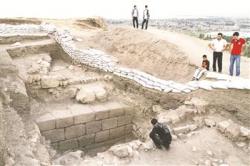 Van - The first palace structure from the Urartu Kingdom has been found in excavations at the top of Van Castle in the eastern province of Van. The excavation work is headed by Professor Erkan Konyar from Istanbul University. The archaeological team has unearthed the earliest structures of the Urartu civilization, Konyar said, adding that they will continue excavating the palace and its surroundings to reveal other structures in the next years. “Its architectural structure shows that the palace was built in the early Urartu period. In 1.5 months of work, the ruins of the palace have been unearthed to a depth of six meters underground. We hope to eventually excavate all of the public buildings of the Urartu civilization,” Konyar said.
Van - The first palace structure from the Urartu Kingdom has been found in excavations at the top of Van Castle in the eastern province of Van. The excavation work is headed by Professor Erkan Konyar from Istanbul University. The archaeological team has unearthed the earliest structures of the Urartu civilization, Konyar said, adding that they will continue excavating the palace and its surroundings to reveal other structures in the next years. “Its architectural structure shows that the palace was built in the early Urartu period. In 1.5 months of work, the ruins of the palace have been unearthed to a depth of six meters underground. We hope to eventually excavate all of the public buildings of the Urartu civilization,” Konyar said.
http://www.hurriyetdailynews.com/urartu-palace-unearthed.aspx?pageID=238&nID=30162&NewsCatID=375
JAPON – 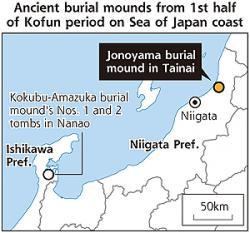 Niigata - The political and cultural influence of the ancient Yamato kingdom reached about 250 kilometers farther north than previously believed, a new archaeological find in Niigata Prefecture has revealed. The board of education of Tainai, Niigata Prefecture, excavated a bronze mirror, magatama beads, a piece of lacquerware and other burial-related items from an ancient Jonoyama burial mound dating back to the first half of the fourth century. The excavated items strongly resemble other pieces found mainly in the Kinki region. Until recently, the reigning belief among scholars was that the northern extent of the Yamato kingdom's influence was the Noto Peninsula on the Sea of Japan, due to the large number of similar burial items found in several locations. The latest find is about 250 kilometers farther north. The Tainai board of education will open the site to the public Saturday and then continue its research, hoping to attain national historic site designation for the burial mound. The round mound stretches about 35 meters north to south, about 40 meters east to west, and is about five meters high, according to the board of education. The burial mound is one of the northernmost on the Sea of Japan among those built in the first half of the Kofun period (ca 300-ca 710). The excavation began in 2005 when a piece of earthenware was discovered at the site. A wooden coffin found in the mound had almost completely decayed, but researchers determined it was boat-shaped, about eight meters long, about 1.5 meters wide, and decorated with red pigment. There is no evidence the mound had been plundered by grave robbers, as a wide variety of items were found inside, including the bronze mirror, magatama beads, a sword and a bow. A lacquered "yuki" box more than 80 centimeters long that was used to store arrows was found in good condition. The box is similar to one excavated from the Yukinoyama Kofun burial mound in Higashiomi, Shiga Prefecture. Burial items discovered at the site have much in common with pieces from ancient burial mounds in the Kinki region, leading the researchers to conclude the site was the grave of an influential person with close ties to the Yamato kingdom. Previously, the northern influence of the Yamato kingdom during the first half of the Kofun period on the Sea of Japan coast could only be confirmed as far as a site in Ishikawa Prefecture--two tombs of the Kokubu-Amazuka burial mounds in Nanao in the prefecture. "I believe the yuki box and other craftwork items were made in the central Kinki region and brought to the site," said Niigata University Prof. Hirofumi Hashimoto, the archaeologist who led the excavation of the Jonoyama mound. "These precious findings prove the Yamato kingdom's influence reached the Tohoku region."
Niigata - The political and cultural influence of the ancient Yamato kingdom reached about 250 kilometers farther north than previously believed, a new archaeological find in Niigata Prefecture has revealed. The board of education of Tainai, Niigata Prefecture, excavated a bronze mirror, magatama beads, a piece of lacquerware and other burial-related items from an ancient Jonoyama burial mound dating back to the first half of the fourth century. The excavated items strongly resemble other pieces found mainly in the Kinki region. Until recently, the reigning belief among scholars was that the northern extent of the Yamato kingdom's influence was the Noto Peninsula on the Sea of Japan, due to the large number of similar burial items found in several locations. The latest find is about 250 kilometers farther north. The Tainai board of education will open the site to the public Saturday and then continue its research, hoping to attain national historic site designation for the burial mound. The round mound stretches about 35 meters north to south, about 40 meters east to west, and is about five meters high, according to the board of education. The burial mound is one of the northernmost on the Sea of Japan among those built in the first half of the Kofun period (ca 300-ca 710). The excavation began in 2005 when a piece of earthenware was discovered at the site. A wooden coffin found in the mound had almost completely decayed, but researchers determined it was boat-shaped, about eight meters long, about 1.5 meters wide, and decorated with red pigment. There is no evidence the mound had been plundered by grave robbers, as a wide variety of items were found inside, including the bronze mirror, magatama beads, a sword and a bow. A lacquered "yuki" box more than 80 centimeters long that was used to store arrows was found in good condition. The box is similar to one excavated from the Yukinoyama Kofun burial mound in Higashiomi, Shiga Prefecture. Burial items discovered at the site have much in common with pieces from ancient burial mounds in the Kinki region, leading the researchers to conclude the site was the grave of an influential person with close ties to the Yamato kingdom. Previously, the northern influence of the Yamato kingdom during the first half of the Kofun period on the Sea of Japan coast could only be confirmed as far as a site in Ishikawa Prefecture--two tombs of the Kokubu-Amazuka burial mounds in Nanao in the prefecture. "I believe the yuki box and other craftwork items were made in the central Kinki region and brought to the site," said Niigata University Prof. Hirofumi Hashimoto, the archaeologist who led the excavation of the Jonoyama mound. "These precious findings prove the Yamato kingdom's influence reached the Tohoku region."
http://www.yomiuri.co.jp/dy/national/T120916001832.htm
INDE – Varanasi - Now one can have a glimpse of antiquity and rare collection of Bharat Kala Bhawan of Banaras Hindu University (BHU) online soon. To match pace with rest of the museums of the world, BKB has started the digital documentation of its collection, which can be accessed online from anywhere in the world.
http://timesofindia.indiatimes.com/city/varanasi/Online-access-to-BHUs-museum-collection-soon/articleshow/16430670.cms
FRANCE – 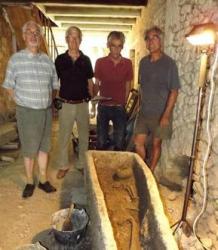 Champagné Saint Hilaire - Lors des travaux de restauration du café restaurant de Champagné-Saint-Hilaire, les employés communaux ont découvert des sarcophages. Après l'effet de surprise, des historiens de la DRAC ont décidé d'en extraire un pour voir quels secrets le sarcophage pourrait dévoiler. Les sarcophages sont cote à cote orientés à l'Est et dateraient d'avant l'an mil. A première vue, le sarcophage a dû être visité il y a bien longtemps, au grand regret des chercheurs, puisqu'il était rempli de terre. Au fur et à mesure du travail délicat et attentionné des chercheurs très émus, quelques petits éléments de poterie sont apparus aux côtés des ossements dont certains déplacés par rapport à la position initiale du squelette. Après un premier examen, il se pourrait que ce soit une femme. Quant à la datation, il va falloir attendre un peu. Comme le souligne Daniel Bourdu, « cette découverte confirme la longue histoire de Champagné. Il faut savoir que la commune, certes victime des événements du 13 août 1944, a la chance d'avoir un énorme fonds d'archives de plusieurs milliers de pages conservé aux archives départementales de la Vienne ; un fait rare pour une commune rurale. Pendant 700 ans, les chanoines de Saint-Hilaire-le -Grand de Poitiers ont conservé les actes des donations et de gestion (série G). Ainsi on peut reconstituer pas à pas l'histoire régionale dans toute sa finesse ». Champagné a donc encore bien des histoires à raconter.
Champagné Saint Hilaire - Lors des travaux de restauration du café restaurant de Champagné-Saint-Hilaire, les employés communaux ont découvert des sarcophages. Après l'effet de surprise, des historiens de la DRAC ont décidé d'en extraire un pour voir quels secrets le sarcophage pourrait dévoiler. Les sarcophages sont cote à cote orientés à l'Est et dateraient d'avant l'an mil. A première vue, le sarcophage a dû être visité il y a bien longtemps, au grand regret des chercheurs, puisqu'il était rempli de terre. Au fur et à mesure du travail délicat et attentionné des chercheurs très émus, quelques petits éléments de poterie sont apparus aux côtés des ossements dont certains déplacés par rapport à la position initiale du squelette. Après un premier examen, il se pourrait que ce soit une femme. Quant à la datation, il va falloir attendre un peu. Comme le souligne Daniel Bourdu, « cette découverte confirme la longue histoire de Champagné. Il faut savoir que la commune, certes victime des événements du 13 août 1944, a la chance d'avoir un énorme fonds d'archives de plusieurs milliers de pages conservé aux archives départementales de la Vienne ; un fait rare pour une commune rurale. Pendant 700 ans, les chanoines de Saint-Hilaire-le -Grand de Poitiers ont conservé les actes des donations et de gestion (série G). Ainsi on peut reconstituer pas à pas l'histoire régionale dans toute sa finesse ». Champagné a donc encore bien des histoires à raconter.
http://www.lanouvellerepublique.fr/Vienne/communes/Champagn%C3%A9-Saint-Hilaire/n/Contenus/Articles/2012/09/12/Le-sarcophage-livre-ses-secrets
ROYAUME UNI – 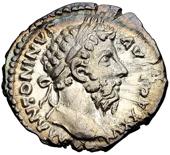 Selby - X-ray computed tomography is now being used to examine damaged or corroded coin hoards in a major scientific breakthrough recently announced through the University of Southampton in collaboration with the British Museum. Tomography involves imaging by sections or sectioning using waves. The Selby Hoard of ancient Roman coins discovered with a metal detector near Selby, East Riding, York, in England was the subject of the first tomographic reconstruction of a coin hoard. In this case the coins were lumped together in the ground when first encountered. Eleanor Ghey is the archaeologist who has been studying this hoard. Ghey has suggested the pot in which the coins were discovered indicates the coins were part of a ritual offering involving both food and money. Chaff was found mixed with the coins. It has been determined that the coins date between the time of Roman Emperors Vespasian and Hadrian, and include coins of Marcus Aurelius and Trajan as well. The Southampton’s µ-VIS Centre for Computed Tomography used an x-ray technique that takes thousands of two-dimensional scans from which a compilation resulted in the 3D animation images of the coin hoard. The equipment had in the past been used to examine such things as jet turbine blades. The high energy/high resolution ability of the Southampton facility allowed the coins to be examined in detail without having been cleaned or examined physically. Visualization capabilities were used to identify the rulers depicted on the coins through the iconography and inscriptions on the coins.
Selby - X-ray computed tomography is now being used to examine damaged or corroded coin hoards in a major scientific breakthrough recently announced through the University of Southampton in collaboration with the British Museum. Tomography involves imaging by sections or sectioning using waves. The Selby Hoard of ancient Roman coins discovered with a metal detector near Selby, East Riding, York, in England was the subject of the first tomographic reconstruction of a coin hoard. In this case the coins were lumped together in the ground when first encountered. Eleanor Ghey is the archaeologist who has been studying this hoard. Ghey has suggested the pot in which the coins were discovered indicates the coins were part of a ritual offering involving both food and money. Chaff was found mixed with the coins. It has been determined that the coins date between the time of Roman Emperors Vespasian and Hadrian, and include coins of Marcus Aurelius and Trajan as well. The Southampton’s µ-VIS Centre for Computed Tomography used an x-ray technique that takes thousands of two-dimensional scans from which a compilation resulted in the 3D animation images of the coin hoard. The equipment had in the past been used to examine such things as jet turbine blades. The high energy/high resolution ability of the Southampton facility allowed the coins to be examined in detail without having been cleaned or examined physically. Visualization capabilities were used to identify the rulers depicted on the coins through the iconography and inscriptions on the coins.
http://www.numismaster.com/ta/numis/Article.jsp?ad=article&ArticleId=25760